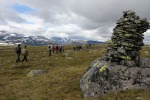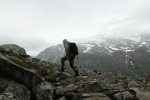“I couldn’t picture you hiking,” said my friend Ignasio presumptuously. His assumption was way too late since we were already steps away from Jotunheimen, Norway. The rocky steep terrain with patches of snow lay before my eyes. I trembled.
When in Norway, do what Norwegians do. Nothing represents it better than hiking, a popular activity during summer. No place can be any better to do that than in Jotunheimen, a national park which lies 240 kilometers northwest of Oslo.
Jotunheimen, meaning “the Home of the Giants”, is the largest mountainous area in Scandinavia where high plateau, valleys, lakes, waterfalls, and glaciers are beautifully intertwined. It is also home for wildlife such as reindeer, elk, and wolverine. It covers roughly 3.500 kilometers zone with at least 200 mountain peaks rising above 2.000 meters. The two highest peaks are Galdhøpiggen (2.469 m) and Glittertind (2.452 m). Approximately, 30.000 people traverse it each year for hiking, skiing, kayaking, or glacier-walking.
It was mid July that supposed to be the warmest season, but summer is winter with a different name for this country located in the northernmost tip of Europe. The temperature in Jotunheimen was 6 degree Celsius and some parts of mountains were still snow-clad. Weather changes quickly in the mountain, so all hikers must be well-equipped with rain gear. Despite all these nature challenges, we –the group of twenty- determined to hike in rain or shine.
Jotunheimen is a place for all kind of people with different level of hiking experience. Besseggen ridge is probably the best option for hiker or even tourist who can endure seven to eight hours walking. Norwegian might even say the Besseggen ridge walk is a ‘rite of passage’ they have to do once in their life. One of the oft-chosen routes is taking ferry from Gjendesheim to Memurubu and then hiking back from Memurubu to Gjendesheim along the Besseggen trail.
It took almost four hours bus ride from Oslo to Gjendesheim, with scenic valleys, lake, forest, and farm along the way. We then took boat across Gjende Lake to Memurubu, a cabin in the mountain where we would spend a night. The lake itself is an ‘appetizer’ for our trip with its glacial water in sparkling emerald color. We arrived in Memurubu after 20 minutes sense-indulging boat trip. The hut was flocked with hikers as we predicted because summer is the busiest hiking season in this country.
We started to climb the next morning at 8.30 in a quite sunny weather. The guide, Karoline Niklasson, had warned me earlier that Besseggen walk could be strenuous because of the first hours we had to walk uphill. I found the truth of her every word. I climbed the cliff with height of 1.000 to 1.600 meters above sea level (masl) for the first three hours. Afterward, I walked downhill for the next one hour before taking a lunch break.
The next stage was even more challenging because we had to walk on the long and narrow snow trail. It was a thrilling experience for someone who had never seen snow all her life like me. Right after it, lays the path leading to Besseggen ridge. The ridge is the steepest incline with only chunks of solid rocks to hold on to. It was getting steeper as I climbed up while the wind was swirling so I did not even dare to look down.
After 200 meters high climbing, there is quite a flat terrain where people usually stop and take pictures. I turned around and could not believe my own eyes. I could see the stony path seemed dividing the emerald-colored Gjende Lake on my left side and deep blue Bessvatn Lake on my right side. Mountainous terrain with some part covered with snow come up through the mist as a background. It is the most dramatic picturesque view from the ridge.
It is not the end of the route. We still had to walk on a flat but stony plateau for the next 50 minutes. The skies darkened and rain seemed to come soon as we finally saw the ‘peak’. It is not a typical peak because it is just a start of the long descent. Walking downhill was another challenge after long hours of ascending. The downward slope is a barren vast land with nothing but rocks and gravels. As I walked down, the view changed gradually where I could see desolate waterfalls, several snow trails, and field of grass and blooming pasque-flowers.
The rain started pouring down right when we arrived at our lodge near the Gjende Lake. When I looked up, I could see nothing but the fog and the snow. It felt like all the spectacular view disappeared just in a second.
Love for Nature
Hiking is one of the most popular activities in Norway. I encountered many groups of hikers along the way who hiked with their friends, families, or even their dogs. My guide told me that hiking alone is not recommended in case there is accident during the trip. There is also a rule that you have to say ‘hi’ to other hikers if you cross paths with them. In the streets of Oslo you might not do the same. So, make sure you still save your breath to say ‘hi’ since in the peak season you will see groups of people hiking.
Having hiked without making blisters is such an accomplishment for me. This journey gives me a bigger picture of Norway as a country with spectacular natural scenery and also Norwegian as a nature-lover people. They engage themselves in outdoor activities even since they are kids. During hiking I could see boys and girls wrapped in thick waterproof jacket happily walk or sometimes run to reach the peak.
I believe that Indonesia has lots of mountain from western to eastern side of the country. But, hiking and climbing seems like a thing only a professional hikers or outdoor-activity junkie do. This trip encourages me to explore Indonesia nature beauty more often.
I was at the home of the giants. As for me, it is the best way to start hiking back home in Indonesia.















